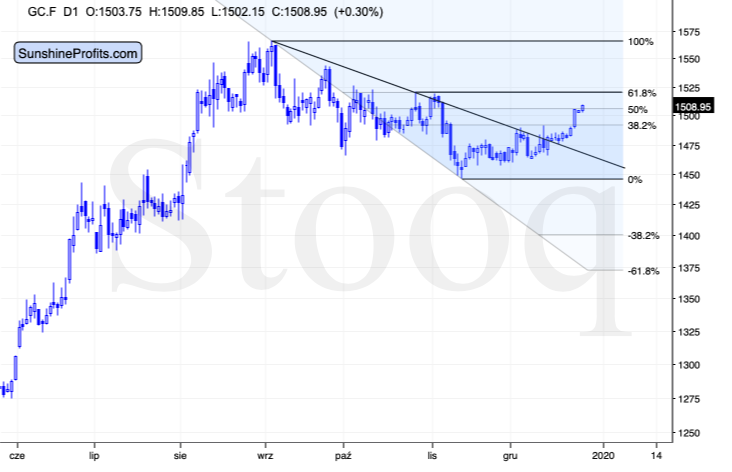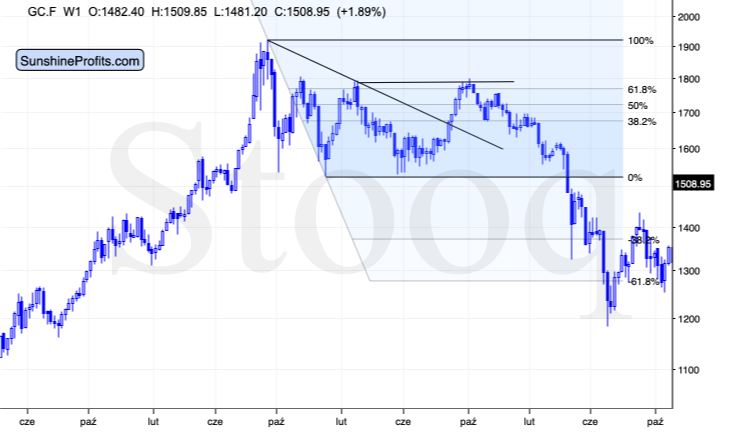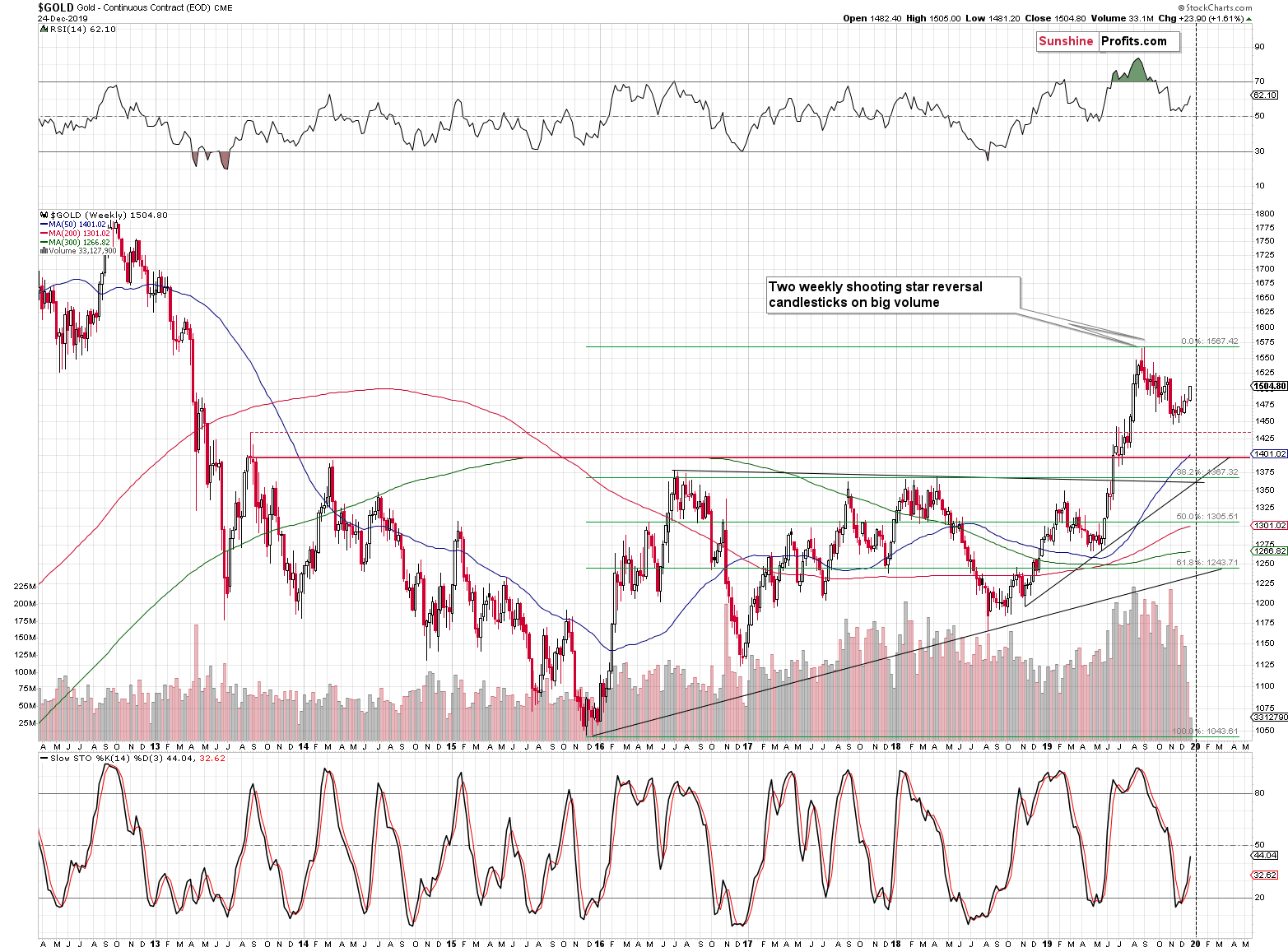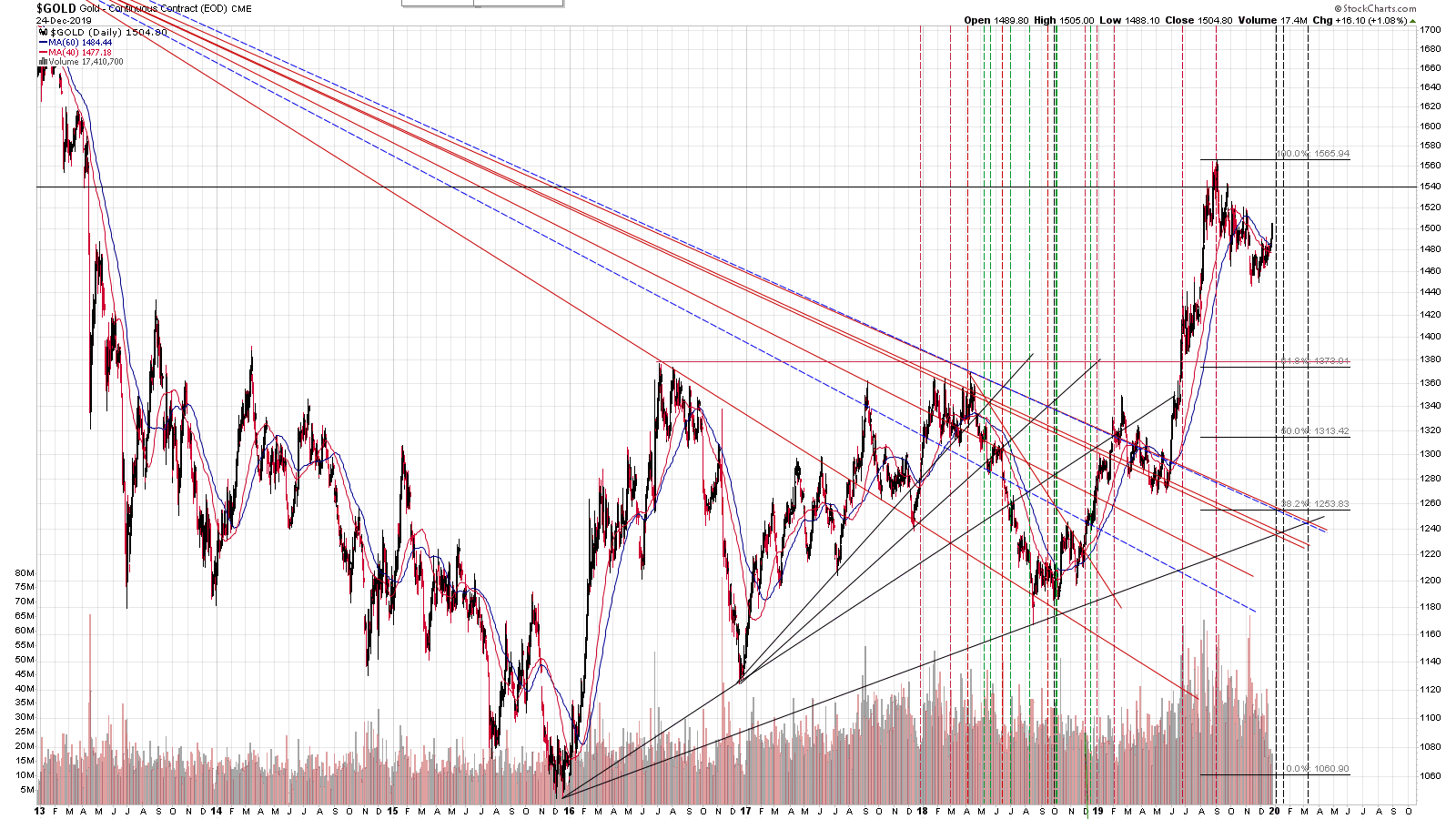Briefly: in our opinion, full (250% of the regular size of the position) speculative short position in gold, silver, and mining stocks is justified from the risk/reward point of view at the moment of publishing this Alert.
The precious metals market is soaring this week and the million-dollar question is how high is gold likely to move given its momentum and what does this move tell us for the outlook in the following months. Fortunately, we've seen this kind of price move before...
Gold is rallying sharply after breaking above the declining resistance line and the 38.2% Fibonacci retracement level. The breakout above these levels was not likely, but it happened, nonetheless. Given the move above the 50% retracement, it seems that gold could move to the classic 61.8% Fibonacci retracement before topping.
Please note that the 61.8% retracement is almost perfectly aligned with the late-October and November highs. Also, please note that the entire September - today decline is taking place after a sharp rally in gold.
Now, where did we see all that before?
In 2012.
Back then gold was also rallying sharply after breaking above the declining resistance line and moving above the 38.2% and 50% Fibonacci retracements.
Gold was after months of declines after the top, and the top was preceded by a sharp rally.
In both cases, gold also formed three separate bottoms before the final corrective upswing. Where did the 2012 corrective upswing end? Approximately at the 61.8% Fibonacci retracement and the previous high. This means that the current gold rally is also quite likely to end its rally at the analogous price level.
This target is at about $1,520 in case of gold futures. Today's pre-market high was about $1,510, which means that the possible upside is relatively close. This also means that it would be a good time to be opening positions aimed to profit from lower gold prices, instead of closing them.
Moreover, let's keep in mind that there are triangle-vertex-based turning points at the end of the year, which is just a few trading days away.
This means that while January - and in particular its first part - are usually bullish for gold, exactly the opposite might be in store in 2020.
Summing up, based on the similarity to the previous price moves, it seems that the rally in gold is now very close to being over. Too close for us to change the trading position at this time. The PMs were not likely to rally this significantly this week, but given that it had already happened, it seems that the very nearby turning points are likely to be tops, instead of bottoms. In other words, the profit potential of our trading positions remains intact.
As always, we'll keep you - our subscribers - informed.
To summarize:
Trading capital (supplementary part of the portfolio; our opinion): Full speculative short position (250% of the full position) in gold, silver, and mining stocks is justified from the risk/reward perspective with the following stop-loss orders and binding exit profit-take price levels:
- Gold futures: profit-take exit price: $1,391; stop-loss: $1,573; initial target price for the DGLD ETN: $36.37; stop-loss for the DGLD ETN: $25.44
- Silver futures: profit-take exit price: $15.11; stop-loss: $19.06; initial target price for the DSLV ETN: $24.88; stop-loss for the DSLV ETN: $14.07
- Mining stocks (price levels for the GDX ETF): profit-take exit price: $23.21; stop-loss: $30.11; initial target price for the DUST ETF: $14.69; stop-loss for the DUST ETF $6.08
In case one wants to bet on junior mining stocks' prices, here are the stop-loss details and target prices:
- GDXJ ETF: profit-take exit price: $30.32; stop-loss: $44.22
- JDST ETF: profit-take exit price: $35.88 stop-loss: $11.68
Long-term capital (core part of the portfolio; our opinion): No positions (in other words: cash)
Insurance capital (core part of the portfolio; our opinion): Full position
Whether you already subscribed or not, we encourage you to find out how to make the most of our alerts and read our replies to the most common alert-and-gold-trading-related-questions.
Please note that the in the trading section we describe the situation for the day that the alert is posted. In other words, it we are writing about a speculative position, it means that it is up-to-date on the day it was posted. We are also featuring the initial target prices, so that you can decide whether keeping a position on a given day is something that is in tune with your approach (some moves are too small for medium-term traders and some might appear too big for day-traders).
Plus, you might want to read why our stop-loss orders are usually relatively far from the current price.
Please note that a full position doesn't mean using all of the capital for a given trade. You will find details on our thoughts on gold portfolio structuring in the Key Insights section on our website.
As a reminder - "initial target price" means exactly that - an "initial" one, it's not a price level at which we suggest closing positions. If this becomes the case (like it did in the previous trade) we will refer to these levels as levels of exit orders (exactly as we've done previously). Stop-loss levels, however, are naturally not "initial", but something that, in our opinion, might be entered as an order.
Since it is impossible to synchronize target prices and stop-loss levels for all the ETFs and ETNs with the main markets that we provide these levels for (gold, silver and mining stocks - the GDX ETF), the stop-loss levels and target prices for other ETNs and ETF (among other: UGLD, DGLD, USLV, DSLV, NUGT, DUST, JNUG, JDST) are provided as supplementary, and not as "final". This means that if a stop-loss or a target level is reached for any of the "additional instruments" (DGLD for instance), but not for the "main instrument" (gold in this case), we will view positions in both gold and DGLD as still open and the stop-loss for DGLD would have to be moved lower. On the other hand, if gold moves to a stop-loss level but DGLD doesn't, then we will view both positions (in gold and DGLD) as closed. In other words, since it's not possible to be 100% certain that each related instrument moves to a given level when the underlying instrument does, we can't provide levels that would be binding. The levels that we do provide are our best estimate of the levels that will correspond to the levels in the underlying assets, but it will be the underlying assets that one will need to focus on regarding the signs pointing to closing a given position or keeping it open. We might adjust the levels in the "additional instruments" without adjusting the levels in the "main instruments", which will simply mean that we have improved our estimation of these levels, not that we changed our outlook on the markets. We are already working on a tool that would update these levels on a daily basis for the most popular ETFs, ETNs and individual mining stocks.
Our preferred ways to invest in and to trade gold along with the reasoning can be found in the how to buy gold section. Additionally, our preferred ETFs and ETNs can be found in our Gold & Silver ETF Ranking.
As a reminder, Gold & Silver Trading Alerts are posted before or on each trading day (we usually post them before the opening bell, but we don't promise doing that each day). If there's anything urgent, we will send you an additional small alert before posting the main one.
Thank you.
Sincerely,
Przemyslaw Radomski, CFA
Editor-in-chief, Gold & Silver Fund Manager







